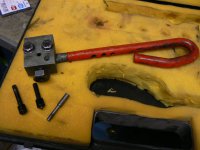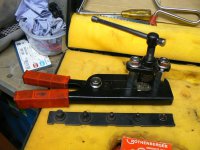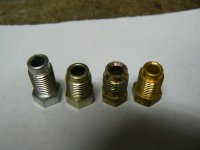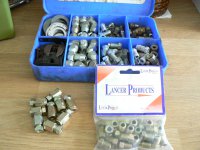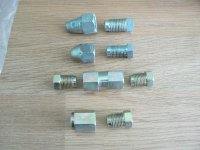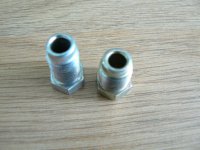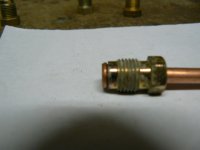I'm back Jack. You ask if I always use new nuts? Yes, most of the time. Because these are safety critical components but also because they tend to corrode badly in service. I do tend to keep old nuts if they are in very good condition and especially if they are an unusual size but I only use them if pressed to do so, maybe because new stock is unavailable. I just dug out my wee collection of tube nuts:
View attachment 215989
Unfortunately the only one with it's label still attached gives no indication as to specification. Reflecting on how I buy these things I just walk into the Factors and ask for a packet of metric or imperial tube nuts, male or female as required. Typically this does the trick but just very occasionally I'll find one that's slightly different - often on an ABS unit. I've been messing about with this sort of stuff for long enough now that I find I can look at it and think "Oh, that's slightly different" in which case I just take the old one with me when I go to the Factor. Can't say I ever have any problems doing it this way.
Here's a selection of common connectors for those who may be reading this but not familiar with the subject:
View attachment 215990
At the bottom there is a metric female on the left and a metric male on the right.
Next up is an in-line connector. This can be useful when connecting replacement tubing into long lengths of pipe - typically front to rear pipes - where perhaps only a small section, often at the rear, is corroded. I don't know if it's a legal requirement but I find MOT inspectors get "twitchy" if you try to use more than one in a pipe run. This actual connector is a female but uou can also buy males if that works better on your particular job (I think the female looks neater?)
Next up is the SAE version of the metric ones at the bottom of the picture. Works just the same but the threads are imperial and you can't really confuse them as they look entirely different - but I've seen people try (sigh).
The top ones are I think from a very old BMC vehicle I worked on many years ago and are just a bigger version of the SAE size mentioned above - to be honest I don't remember much about them. Just chucked tham in here to illustrate that, if you're not observant, it's quite possible to get mixed up. Always try a new nut into the fitting on a dry run before using it just to check it's the correct size and thread.
If you look at the shape of the female nuts in particular the difference is very obvious.
Then there's the DIN vs SAE "problem"? Well take a look at this:
http://www.fedhillusa.com/?page=fla...e.&text=If the end of the,it is the DIN flare. The SAE flare is on the left and the DIN on the right. Notice the SAE is chamfered on the back of the flare where the tube nut is going to push against it whereas the DIN is at right angles to the pipe. You would expect therefore that the SAE tube nut bore will be heavily chamfered and the DIN one will be squared off? However have a look at this:
View attachment 215991
The one on the left is an SAE and the right one is a Metric DIN. See much difference? No, neither do I. Both are slightly chamfered. I've been making flares with both my SAE flaring tools for years on both metric and imperial fittings and never had a problem. I used to worry that if an SAE flare were used with a metric DIN nut that the shoulder on the Metric nut might cut into the taper produced by the SAE flaring tool on the back side of the flare. In practice I've never seen this happen.
So, if we consider the Metric tube nut and the pipe flared using the SAE flaring tool then take a look at this SAE flare made with one of my old tools with a DIN nut:
View attachment 215992
its a lovely fit isn't it? The end of the pipe is a No2 flare whereas the ones in the link above are No1 flares. Don't let that throw you though as it's the way the flare sits into the nut which is important.
I honestly couldn't tell you how many flares I've done like this and never had a problem at all, No leaks and no pipe fractures, even after years in service. Perhaps it's relevant that I use Cupro Nickel (Kunifer) Pipe on longer runs because it's a lot more rigid than pure copper but I happily use copper for shorter runs, especially if there's a lot of bends to form which are a lot easier to do with soft copper. Beware using pure copper on long runs as it's so soft it will sag. You'll need to fit extra retaining clips which is a pain on some vehicles. Also only bend once! It work hardens so if you bend it and then try to straighten it out again you will weaken it and it may fail in service unless you anneal it (another subject all together) - Sorry Jack, I'm sure you'll know this but I thought I'd put it in for people who may be reading but don't have the experience.
I suppose the official recommendation must be to use a DIN flaring tool with metric fittings and an SAE with Imperial sizes. Up to the individual to make their minds up on this but it would be daft, if you don't yet own a tool, to buy an SAE flaring tool to do DIN flares! Oh, and beware, many of the cheaper tools will only do SAE flares and only on "soft" pipe so copper or, maybe, Cupro Nickel. Definitely not steel which is going to be the original manufacturer fitment. Ok if you are replacing a complete pipe but no good if you are patching into an original front to rear pipe, for instance. If you form the "wrong" flare type for the nut being used (as I sometimes do, ie, using my SAE tools to flare pipe being used with metric nuts) then you'll need to be prepared to take responsibility, as I do, if it all goes wrong! So, if you are inexperienced and not too sure what you're doing don't risk it. The outcome could be lethal!
Well, sorry if a lot of that was stuff you already know Jack - I'm sure a lot of it was - but I thought it might interest others?


